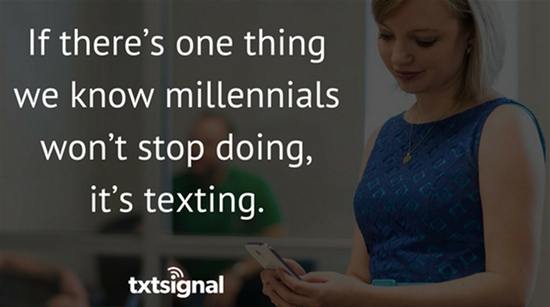In case you haven't heard in the last decade or so: Millennials are kind of a big deal.
We've become used to hearing about Millennials as "the next generation of consumers," people who are young now but whose purchasing power will grow as they grow up.
That's no longer the case. Millennials are adults now. Their school days are behind them. Many are married. They have children. Most have careers, salaries, and expenses.
They're not the next generation. They're the current generation.
Need proof? Look at the spending power that generation has today:

Now think about how that spending ticks up with every month that passes!
How to Reach Those Millennials
Your customers are Millennials, plain and simple. And if you're not one of them, they can be a tough group to figure out!
Generation theory is a huge, interesting field of study in and of itself. In addition to the typical cyclical nature of patterns among generations, each one has its defining events and moments. (How did WWII affect the Boomers, and how is that different from how 9/11 affected Millennials?)
We can go on and on about the differences, and have a ton of fun with it, but we don't need to know everything about Millennials to catch their attention. We just have to know where they are.
As the first generation of digital natives, Millennials are just about always online. If they're not, they have a connected device within a few feet from them at all times.
The trouble is, the Internet is huge.
Where do you start? They could be on Snapchat today, maybe a particular group is playing a certain game next month, others still are different platforms at different times.
The digital landscape can be tough to navigate, and even tougher to keep up with. So let's start with what we know:
- 39% of Millennials interact more with their phones than they do with real humans, according to Bank of America research.
- Millennials make up 29% of America's population but account for 41% of its smartphone usage, according to Experian.
- Millennials go to their mobile phones first for communication.
It's safe to say if you want to go where they are, go to their phones!
Break Through the Clutter
No other generation has had more messages in their face each day. Millennials have had distractions, advertisements, calls to action, and every sort of marketing thrown at them since they were born.
As a result, they've gotten good at tuning it all out.
Millennials are happy to engage with your business... as long as it's worth their time.
Back to Basics
If there's one thing we know Millennials won't stop doing, it's texting.
Text message marketing, or SMS marketing, is one of the fastest-growing forms of mobile marketing for a few reasons:
- It's simple
- It's powerful
- It's not going anywhere
Whereas mobile apps and social platforms come and go, text messages have endured as the staple of mobile phones. Ask anyone under 35 whether they use their phone more for phone calls or texts, and you'll understand.

Text Me, Maybe?
Here's a quick rundown of how SMS marketing works:
- A business uses an SMS platform to set up a shortcode—a 5-digit number that acts as the sending and receiving mechanism.
- Customers (and potential customers) can text a keyword to that shortcode to be added to the business's SMS contact list.
- The business can then send out short texts, about the length of a tweet, to its contact list.
- A text includes a call to action, such as "show this text at checkout for 10% off your purchase of $40 or more!"
- Customers can choose to opt out at any time.
Talk about simplicity!
Powerful Results
While you're not likely to use SMS marketing for brand awareness, it can be a powerful tool to drive immediate sales.
Get this: Text messages have a 98% read rate in the first two minutes.
That's a huge statistic. That's unheard of in any sort of marketing. Email open rates have been hovering at a little under 20% for years.
And it makes sense. When we receive a text, we check it. When was the last time you let a text sit unread? Even if you have another app open, you get a notification for a text over what you're doing, and you're likely to check it immediately.
From a deliverability and engagement perspective, nothing else even comes close.
But what about real results—the bottom line?
Ultimately, it comes down to what you offer customers. As with any other form of marketing, you have to offer something your customers want.
Many businesses use coupons, deals, or specials to get people in the door. Texts make doing so easy. Either send a link to a digital offer, or have customers show the text to receive the discount. You can even add in an expiration date.
With offers like these, we've seen redeem rates between 12% and 20%.
Think about that: That's a huge success rate that translates to people actually coming through the door and making a purchase!
Reach Millennials Where They Are
Millennials constitute a huge opportunity for business. Reaching this generation is not optional. They are your customers. Now.
They're also a highly mobile-centric group, the first one of its kind. There's a certain challenge in reaching an audience that's always on the go. Where do you go to get their attention if they never stay in the same spot?
Turns out, it's easier to go with them, because there's one place we know Millennials will always be: on their phones.




